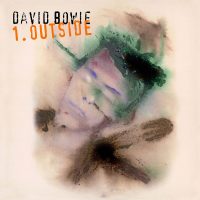 Recorded: May 1994 – February 1995
Recorded: May 1994 – February 1995
Producers: David Bowie, Brian Eno, David Richards
Released: 25 September 1995
Personnel
David Bowie: vocals, saxophone, guitar, keyboards
Brian Eno: synthesizers, treatments, strategies
Reeves Gabrels, Carlos Alomar, Tom Frish, Kevin Armstrong: guitar
Erdal Kızılçay: bass guitar, keyboards
Yossi Fine: bass guitar
Mike Garson: piano
Sterling Campbell, Joey Baron, Neil Conti: drums
Bryony Edwards, Josey Edwards, Lola Edwards, Ruby Edwards: backing vocals
Tracklisting
- ‘Leon Takes Us Outside’
- ‘Outside’
- ‘The Hearts Filthy Lesson’
- ‘A Small Plot Of Land’
- ‘Segue – Baby Grace (A Horrid Cassette)’
- ‘Hallo Spaceboy’
- ‘The Motel’
- ‘I Have Not Been To Oxford Town’
- ‘No Control’
- ‘Segue – Algeria Touchshriek’
- ‘The Voyeur Of Utter Destruction (As Beauty)’
- ‘Segue – Ramona A Stone’
- ‘I Am With Name’
- ‘Wishful Beginnings’
- ‘We Prick You’
- ‘Segue – Nathan Adler’ (1)
- ‘I’m Deranged’
- ‘Thru’ These Architects Eyes’
- ‘Segue – Nathan Adler’ (2)
- ‘Strangers When We Meet’
A fin de siècle murder mystery subtitled ‘The Nathan Adler Diaries: A Hyper-cycle’, 1.Outside was David Bowie’s first concept album since 1974’s similarly dystopian Diamond Dogs. The album owed much to Bowie’s interests in visual art and new technology.
In 1995 Bowie stood at a crossroads. He had successfully disengaged himself from the wilderness that had blighted his mid-to-late ’80s output, had gone back to rock basics with Tin Machine, put out a credible and innovative pop record in Black Tie White Noise, and revitalised his creative muse with the underrated and widely ignored The Buddha Of Suburbia.
That last album, released in 1993, saw Bowie harking back to his glory years, from the late ’60s to the start of the 1980s. He drew on the past lyrically and musically, but also used new technology to sample, cut up and rearrange music into new forms.
He was, in this, heavily inspired by Brian Eno, whose pivotal role in the so-called ‘Berlin trilogy’ – Low, “Heroes”, and Lodger – was to destabilise and reinvigorate the creative process with unconventional techniques.
It was only towards the end of the Eighties that we both started feeling active and wanting to do new things – Brian with U2 and me with Tin Machine. It was really fortuitous that we got back together in ’92 and realized that we both, again, wanted to approach music the same way we did back in the Seventies. We defined the subject matter and the musical style of the stuff we didn’t want to do and that we felt was probably being done by other people – very well or not – and we just went to the edge in both subject matter and style of playing.
Seconds magazine, August/September 1995
The two men had discussed working together again at Bowie’s wedding celebration in Florence, Italy, on 6 June 1992.
Bowie: A pivotal moment for us was actually at the wedding.Eno: It’s absolutely true, that’s where we first talked about it.
Bowie: I was just starting the instrumental backings for the Black Tie White Noise album and I had some of them, just as instrumental pieces at the wedding, because it was written half around the idea of the marriage ceremony. Brian at the time was working on Nerve Net, and we realised that we were suddenly on the same course again.
Eno: That was quite interesting, because it was the wedding reception, right, everybody was there, and we started talking and Dave said, ‘You’ve got to listen to this!’ He went up to the DJ and said, ‘No, take that off, play this.’
Bowie: And then we both rushed off to our individual lives knowing it was almost inevitable we’d be working together again. Because we both felt excited about the fact that neither of us was excited about what was happening in popular music.
The pair remained in touch after the wedding celebration, and had a lengthy correspondence on the future of music.
We were both interested in nibbling at the periphery of the mainstream rather than jumping in. We sent each other long manifestoes about what was missing in music and what we should be doing. We decided to really experiment and go into the studio with not even a gnat of an idea.
USA Today, 14 September 1995
Such was the backdrop to 1.Outside. The album proved divisive upon its release, with fans and critics equally enamoured and deterred by its considerable length, experimental nature, and opaque storytelling.
In time, however, it became recognised as a pivotal album for Bowie, marking the point in which he fully pursued his artistic visions with little heed to prevailing fashion or record company demands.
I personally think my work in the ’90s has been the best that I could possibly do. It’s proved to have a lot of life and it’s got some strong devotees. From Black Tie…, I think I’ve not put out a shoddy piece of work. I’m very proud of it all. Especially things like The Buddha Of Suburbia, which went – pffft – under the radar. Maybe Buddha was an indication that I’d be going back into more experimental stuff, like Outside, again.
Uncut, October 1999



This is really interesting, and very nicely written. I have a very minor quibble. That “Ikon” quote is slightly wrong. “It was important for this town, this locale, to have a populous…” says Bowie.
The correct noun is “populace” – “populous” is a homophonic adjective that isn’t appropriate here.
Thank you Tony! Corrected now.